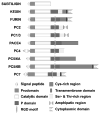Proteolytic and non-proteolytic roles of membrane type-1 matrix metalloproteinase in malignancy
- PMID: 19406172
- PMCID: PMC2823998
- DOI: 10.1016/j.bbamcr.2009.04.009
Proteolytic and non-proteolytic roles of membrane type-1 matrix metalloproteinase in malignancy
Abstract
This manuscript provides an overview of the dynamic interactions which play an important role in regulating cancer cell functions. We describe and discuss, primarily, those interactions which involve membrane type-1 matrix metalloproteinase (MT1-MMP), its physiological inhibitor tissue inhibitor of metalloproteinases-2 (TIMP-2), furin-like proprotein convertases and the low density lipoprotein-related protein 1 (LRP1) signaling scavenger receptor. The interaction among these cellular proteins controls the efficiency of the activation of MT1-MMP and the unorthodox intracellular signaling which is generated by the catalytically inert complex of MT1-MMP with TIMP-2 and which plays a potentially important role in the migration of cancer cells. Our in-depth understanding of these cellular mechanisms may provide the key to solving the puzzling TIMP-2 paradox. This unsolved paradox arises from the fact that TIMP-2 is a powerful inhibitor of MMPs including MT1-MMP, but at the same time high levels of TIMP-2 positively correlate with an unfavorable prognosis in cancer patients. Solving the TIMP-2 paradox may lead to solving a similar PAI-1 paradox and produce a clearer understanding of the biochemical mechanisms which control the functionality of the urokinase-type plasminogen activator*urokinase receptor*plasminogen activator inhibitor type-1 (uPAR*uPA*PAI-1) system in cancer.
Copyright 2009 Elsevier B.V. All rights reserved.
Figures


Similar articles
-
Tissue inhibitor of metalloproteinases-2 binding to membrane-type 1 matrix metalloproteinase induces MAPK activation and cell growth by a non-proteolytic mechanism.J Biol Chem. 2008 Jan 4;283(1):87-99. doi: 10.1074/jbc.M705492200. Epub 2007 Nov 8. J Biol Chem. 2008. PMID: 17991754
-
TIMP-2 Interaction with MT1-MMP Activates the AKT Pathway and Protects Tumor Cells from Apoptosis.PLoS One. 2015 Sep 2;10(9):e0136797. doi: 10.1371/journal.pone.0136797. eCollection 2015. PLoS One. 2015. PMID: 26331622 Free PMC article.
-
Activity and expression of urokinase-type plasminogen activator and matrix metalloproteinases in human colorectal cancer.BMC Cancer. 2006 Aug 18;6:211. doi: 10.1186/1471-2407-6-211. BMC Cancer. 2006. PMID: 16916471 Free PMC article.
-
Coordinate action of membrane-type matrix metalloproteinase-1 (MT1-MMP) and MMP-2 enhances pericellular proteolysis and invasion.Cancer Sci. 2010 Apr;101(4):843-7. doi: 10.1111/j.1349-7006.2010.01498.x. Epub 2010 Jan 18. Cancer Sci. 2010. PMID: 20148894 Free PMC article. Review.
-
MT1-MMP as a Key Regulator of Metastasis.Cells. 2023 Aug 31;12(17):2187. doi: 10.3390/cells12172187. Cells. 2023. PMID: 37681919 Free PMC article. Review.
Cited by
-
Non-destructive and selective imaging of the functionally active, pro-invasive membrane type-1 matrix metalloproteinase (MT1-MMP) enzyme in cancer cells.J Biol Chem. 2013 Jul 12;288(28):20568-80. doi: 10.1074/jbc.M113.471508. Epub 2013 Jun 3. J Biol Chem. 2013. PMID: 23733191 Free PMC article.
-
Intradomain cleavage of inhibitory prodomain is essential to protumorigenic function of membrane type-1 matrix metalloproteinase (MT1-MMP) in vivo.J Biol Chem. 2011 Sep 30;286(39):34215-23. doi: 10.1074/jbc.M111.264036. Epub 2011 Aug 8. J Biol Chem. 2011. PMID: 21832072 Free PMC article.
-
MT1-MMP and RECK: opposite and essential roles in hematopoietic stem and progenitor cell retention and migration.J Mol Med (Berl). 2011 Dec;89(12):1167-74. doi: 10.1007/s00109-011-0792-9. Epub 2011 Aug 13. J Mol Med (Berl). 2011. PMID: 21842347 Review.
-
Immune Infiltration of MMP14 in Pan Cancer and Its Prognostic Effect on Tumors.Front Oncol. 2021 Sep 17;11:717606. doi: 10.3389/fonc.2021.717606. eCollection 2021. Front Oncol. 2021. PMID: 34604053 Free PMC article.
-
Novel Roles of MT1-MMP and MMP-2: Beyond the Extracellular Milieu.Int J Mol Sci. 2022 Aug 23;23(17):9513. doi: 10.3390/ijms23179513. Int J Mol Sci. 2022. PMID: 36076910 Free PMC article. Review.
References
-
- Stocker W, Bode W. Structural features of a superfamily of zinc-endopeptidases: the metzincins. Curr Opin Struct Biol. 1995;5:383–390. - PubMed
-
- Gomis-Ruth FX. Structural aspects of the metzincin clan of metalloendopeptidases. Mol Biotechnol. 2003;24:157–202. - PubMed
-
- Egeblad M, Werb Z. New functions for the matrix metalloproteinases in cancer progression. Nat Rev Cancer. 2002;2:161–174. - PubMed
-
- Nagase H, Woessner JF., Jr Matrix metalloproteinases. J Biol Chem. 1999;274:21491– 21494. - PubMed
Publication types
MeSH terms
Substances
Grants and funding
LinkOut - more resources
Full Text Sources
Research Materials
Miscellaneous

